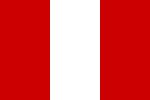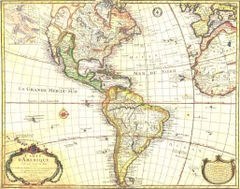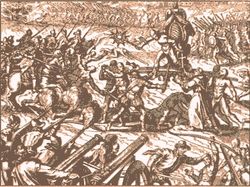Spanish conquest of the Inca Empire
2007 Schools Wikipedia Selection. Related subjects: General history
There lies Peru with its riches;
Here, Panama and its poverty.
Choose, each man, what best becomes a brave Castilian.
— Francisco Pizarro
 |
|---|
| History of Peru |
| Timeline |
| Ancient Peru |
| Caral |
| Chavin |
| Paracas |
| Moche |
| Nazca |
| Tiahuanaco |
| Wari |
| Chimu |
| Inca Empire |
| Colonial Peru |
| The Conquest |
| Viceroyalty of Peru |
| Republic of Peru |
| Independence |
| Peru-Bolivian Confederacy |
| War of the Pacific |
| Peruvian-Ecuadorian Territorial Dispute |
In the 16th century, Spaniards arrived in the Andean region of South America and over the course of only a few decades, succeeded in toppling the Tawantinsuyo, which had spanned most of the Andean region and surrounding lowlands from the south of modern-day Colombia to the north of Chile and Argentina. This article examines how the Conquistadors accomplished this task and describes the events of the twilight years of the Inca empire.
Francisco Pizarro and his brothers were attracted by the news of a rich and fabulous kingdom. In 1531, they arrived to this country, which they called Peru. According to Porras Barrenechea, Peru is not a Quechuan nor Caribbean word, but Indo-Hispanic or Hybrid. At that moment, the Inca Empire was sunk in a five years war between two princes: Huáscar and Atahualpa. Taking advantage of this contingency, Pizarro carried out a “ coup d’état”. On November 16, 1532, while the natives were in a celebration in Cajamarca, the Spanish Pizarro took the Inca Atahualpa prisoner by surprise, causing a great consternation between the natives and conditioning the future course of the fight.
During a certain period of time, Pizarro maintained the authority of the Inca, recognizing Atahualpa as the Inca at that moment. But the conqueror’s abuses made this fiction disappeared. The Spanish domination was consolidating itself as the successive indigenous rebellions were continuously bloodily repressed.
The struggle to have the power, faced Pizarro and Diego de Almagro. An interminable civil war was originated. Despite of this, the Spaniards did not neglect the colonizing process. Its more significant act was the foundation of Lima in January, 1535 , from which the political and administrative institutions were organized. The necessity of consolidating a Spanish Real Authority on these territories, lead to the creation of a Real Audiencia (Royal Audience). In 1542, the Spanish created the Viceroyalty of New Castilla, that shortly after would be called Viceroyalty of Peru. Nevertheless, the Viceroyalty of Peru was not organized until the arrival of the Viceroy Francisco de Toledo in 1572. Toledo ended the indigenous state of Vilcabamba, executing the Inca Tupac Amaru. He also promoted the economic development from the commercial monopoly and the mineral extraction, mainly, from argentiferous mines of Potosí. He took advantage of the Inca institution called “ mita” to put the native communities under a cruel economic enslavement.
The Viceroyalty of Peru became the richest and powerful Spanish Viceroyalty of America in the XVIII century. The creation of the Viceroyalties of New Granada and Rio de la Plata (at the expense of its territory), the commerce exemptions that moved the commercial centre from Lima to Caracas and Buenos Aires, and the fall of the mining and textile production determined the progressive decay of the Viceroyalty of Peru. These events created a favorable climate so that the emancipating ideas had an effect on the Creoles.
 |
| Spanish colonization of the Americas |
| History of the conquest |
|
Inter caetera |
| Conquistadors |
|
Vasco Núñez de Balboa |
Background
By the 16th century, the Inca empire had seen many years of strong leadership. Huayna Capac, the Inca in power when Europeans began to arrive in South America, was respected and admired throughout the empire.
Both Huayna Capac and his designated heir died, most likely of smallpox. The ensuing war of succession between the Panakas (royal lines) weakened the Inca leadership and contributed to its speedy downfall. At the centre of the conflict were the two main contenders, Huascar and Atahualpa, who were both sons of Huayna Capac.
Huascar may have been proclaimed the new emperor, though no records remain to confirm that he was indeed the intended heir. Regarded as ugly, bad-mannered and half-mad, Huascar was known for his cruelty and came close to murdering his sister and mother. Nonetheless, he was well-liked in the southern regions of the empire. Atahualpa, on the other hand, was chosen to govern the northern territory known as the Kingdom of Quito, which was located in modern-day Ecuador and southern Colombia.
After a few years of relative peace, war broke out between the two brothers. It is estimated that 100,000 people were killed in this bloodthirsty dispute known as the War of the Two Brothers. After many struggles, Atahualpa finally defeated Huascar. Atahualpa himself teetered towards insanity and treated the losers terribly. Many had stones dropped on their backs to cripple them, fetuses were ripped from wombs and bodies were stuck on spikes for display, and nearly 1,500 members of the royal family were cut up in front of Huascar, including his own children.
After sending Huascar to prison, Atahualpa took the throne. He paid a terrible price for his cruelty, as it had contributed to the weakening of the empire. It was at this critical moment in the empire's history that the Spanish conquistadors under Francisco Pizarro arrived and after three long expeditions had already established the first Spanish settlement in northern Peru, calling it San Miguel de Piura on July of 1532. Pizarro sent his fellow conquistador, Hernando de Soto, to explore the land and soon returned with an envoy from the emperor Atahualpa, bringing presents and an invitation for a meeting with the Spanish.
The Spanish conquest
After his victory over his brother, Atahualpa began his southward march from Quito to claim the Inca throne in Cusco. Atahualpa had been hearing tales of "white bearded men" approaching his territory. Some accounts say that Atahualpa sent messengers with presents to Pizarro and his men to induce them to leave, and others contend that it was Pizarro who sent a messenger to Atahualpa requesting a meeting. Most accounts agree, however, that Atahualpa met with Pizarro voluntarily.
Atahualpa and his forces met with the Spaniards at Cajamarca on the evening of November 15th. Rather than meeting with Atahualpa himself, Pizarro sent Hernando de Soto, friar Vincente de Valverde and native interpreter Felipillo to speak with the Inca leader.
De Soto spoke with Atahualpa for a while and told them that they were emissaries from King Charles I of Spain. They also said they came in peace and were prepared to serve him against his enemies. Atahualpa nearly scoffed at that as he believed their behaviour was not what one would expect of embassies and emissaries. In fact he knew of their earlier atrocities against the nuns dedicated to serve the god Inti in his temple. He demanded a full accounting of their behaviour in his country and an apology from their leader Pizarro. He did however agree to meet with them in the city the next day.
De Soto noticed the sight of his horses were unnerving some of the Inca's attendants so with an incredible display of horsemanship, he performed the tricks an experienced horseman would do. He stopped short of the Inca with the horse just inches away from Atahualpa. While this frightened the attendants, the Inca was unblinking. This told the Spaniards that they were not dealing with a fearful one like Moctezuma II in Mexico and it gave them even more fear the night of the 15th and early on the 16th. However it gave Pizarro the idea he needed to win Peru.
The next morning, Pizarro had his men strategically placed around the square where they were to meet. When Atahualpa came with 4,000 unarmed soldiers and attendant, Friar Valverde spoke with him about the Spanish presence in his lands as well as engaged in a poorly executed attempt to explain to him the precepts of the Catholic religion, an attempt which was certainly not helped by an unskilled translator. After doing so, he offered Atahualpa a Bible in the expectation that he and his men would immediately convert to Christianity or be considered an enemy of the Church and of Spain by the Spanish Crown.
Atahualpa stated that he was no one's vassal and asked where they got their authority to do this. A popular but widely disputed legend states that Valverde pointed to the Book saying that it contained God's word and handed it over to Atahualpa. Supposedly, when the Inca was presented with the Book he shook it close to his ear and asked "Why doesn't it speak to me?" Having literally never seen a book before, then threw the unfamiliar object aside. Supposedly, this is what gave the Spanish a reason to attack, starting the Battle of Cajamarca on November 16, 1532. Pizarro executed Atahualpa's 12 man honour guard and took the Inca captive at the so-called ransom room. The fact that a small number of Spanish troops were able to defeat the thousands of Inca warriors at Cajamarca is attributable to many factors, among them that the Spanish had horses, and the fact that the Inca Empire had a highly centralized chain of command, which meant that since the Spanish held the emperor hostage, the empire was effectively paralyzed for a time. The Spanish weapons included heavy metal swords and shields, some had guns and perhaps cannons. The Inca's weapons were by far inferior to those of the Spaniards. The Inca used heavy cloth, wood, and leather for their armor. The Inca weapons were made of sharpened stones and wood that they used as spears as well as bows and arrows. There were many more Incas than Spaniards; this added to the Inca's inability to comprehend the threat of the Spanish. Due to disease, internal unrest, and the capture of their emperor, as well as the aforementioned reasons, the Incas were eventually defeated. Some of the same factors contributed to the success of similar, small Spanish bands against the Aztecs and other American civilizations.
During Atahualpa's captivity, the Spanish, although greatly outnumbered, forced him to order his generals to back down by threatening to kill him if he did not. In exchange for his release, Atahualpa offered to fill a large room with gold and promised the Spanish twice that amount in silver. While Pizarro ostensibly accepted the offer and allowed the gold to pile up, he had no intention of releasing the Inca; he needed Atahualpa's influence over his generals and the people in order to maintain the peace.
Atahualpa feared that if Huascar came into contact with the Spanish, he would be so useful to them that Pizarro would no longer need Atahualpa and have him killed. To avoid this, Atahualpa ordered Huascar's execution, which took place not far from Cajamarca.
In the end, this tactic was futile. Months passed, and as it became clear to Atahualpa that the Spanish did not intend to free him, he began to call on his generals to launch an attack on the Spanish. Still outnumbered and fearing an imminent attack from the Inca general Rumiñahui, the Spanish began to see Atahualpa as too much of a liability. He was charged with 12 crimes, the most grave being attempting to revolt against the Spanish, practicing idolatry and murdering his brother, Huascar. He was found guilty of all 12 charges and garroted on August 29, 1533.
Rebellion and reconquest
The situation went quickly downhill. As things began to fall apart, many parts of the Inca Empire revolted, some of them joining with the Spanish against their own rulers.
After Atahualpa's execution, Pizarro installed Atahualpa's brother, Tupac Huallpa, as a puppet Inca ruler, but he soon died unexpectedly, leaving Manco Inca Yupanqui in power. He began his rule as an ally of the Spanish and was respected in the southern regions of the empire, but there was still much unrest in the north near Quito where Atahualpa’s generals were amassing troops. Atahulapa's death meant that there was no hostage left to deter the these northern armies from attacking the invaders. Led by Atahualpa’s generals Rumiñahui, Zope-Zupahua and Quisquis, the native armies inflicted considerable damage on the Spanish. In the end, however, the Spanish succeeded in re-capturing Quito, effectively ending any organized rebellion in the north of the empire.
Manco Inca initially had good relations with Francisco Pizarro and several other Spanish conquistadors. However, in 1535 he was left in Cusco under the control of Pizarro’s cousins Juan and Gonzalo, who so mistreated Manco Inca that he ultimately rebelled. Under the pretense of performing religious ceremonies in the nearby Yucay valley, Manco was able to escape Cusco.
Diego de Almagro, originally one of Francisco Pizarro's party, returned from his exploration of Chile, disappointed in not finding any wealth similar to that of Peru. King Charles I of Spain of Spain (Holy Roman Emperor Charles V) had awarded the city of Cuzco to Pizarro, but Almagro attempted to claim the city nonetheless. Manco Inca hoped to use the disagreement between Almagro and Pizarro to his advantage and organized the recapture of Cusco in 1536. However, Inca revolts such as these were of a small-scale and short-lived, and the Incas leadership did not have the full support of all its subject peoples. Spanish reinforcements arrived and took the city once again.
After the Spanish regained control of Cuzco, Manco Inca and his armies retreated to the fortress at Ollantaytambo. When it became clear that they were outnumbered and defeat was imminent, they retreated further to the mountainous region of Vilcabamba, where the Manco Inca continued to hold some power for several more decades. His son, Túpac Amaru, was the last Inca. After deadly confrontantions, he was murdered by the Spanish in 1572.
The Spaniards destroyed almost every Inca building in Cuzco, built a Spanish city over the old foundations, and proceeded to colonize and exploit the former empire.
In total, the conquest took about forty years to complete. Many Inca attempts to regain the empire had occurred, but none had been successful. Thus the Spanish conquest was achieved through relentless force, zealous fanatism and deceit aided by factors like smallpox and a great communication and cultural devide. The Spaniards displaced most of the Incan past and imposed the Spanish culture on the native population.
In fiction
The conquest of the Incas is dramatized in Peter Shaffer's play The Royal Hunt of the Sun. In the play, Pizarro, Atahualpa, Valverde and other historical figures appear as characters.
The conquest is also used as a starting point for the Matthew Reilly novel Temple, where the siege of Cusco is used. Many historical figures are mentioned, especially with Pizarro who is mentioned as the pursuer of the protagonist.
Quotes
- "When has it ever happened, either in ancient or modern times, that such amazing exploits have been achieved? Over so many climes, across so many seas, over such distances by land, to subdue the unseen and unknown? Whose deeds can be compared with those of Spain? Not even the ancient Greeks and Romans." - Francisco Xerez, Pizarro's secretary, in his "Report on the Discovery of Peru".
- "When I set out to write for the people of today and of the future, about the conquest and discovery that our Spaniards made here in Peru, I could not but reflect that I was dealing with the greatest matters one could possibly write about in all of creation as far as secular history goes. Where have men ever seen the things they have seen here? And to think that God should have permitted something so great to remain hidden from the world for so long in history, unknown to men, and then let it be found, discovered and won all in our own time!" - Chronicle of Peru by conquistador-turned-historian Pedro de Cieza de Leon.
